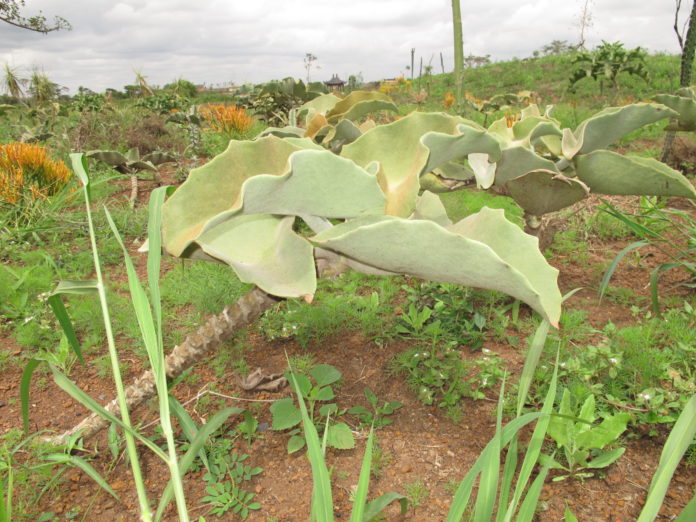By Mary Mwendwa
Construction of a joint botanical garden research center at the Jomo Kenyatta University of Agriculture and Technology (JKUAT) in Kenya is underway.
The garden, which hosts over 400 species of indigenous and foreign plants sits on a 40-acre piece of land within the expansive JKUAT facility.
The botanical garden, which is run by Sino–Africa Joint Research Centre (SAJOREC) together with Chinese Academy of sciences and JKUAT seeks to bolster collaborative research and promote conservation of biodiversity through learning, training, and research.
The piece of land has a complete research facility with laboratories, accommodation, and the garden which although still in progress has already started attracting wildlife like water birds, fish, and other animals.
The garden will also restore some of the indigenous plants which have been disappearing in Kenya. They will collect both unique endangered plants found locally and other parts of the world.
According to Professor Qing –Feng Wang, Director, Sino –Africa Joint Research Centre, Chinese Academy of sciences says the idea was born when Kenya’s Prof. Robert Gituru, Founder – Director SAJOREC, Jomo Kenyatta University of Agriculture and Technology (JKUAT) was pursuing studies in China. Prof. Wang, who is also the director of Wuhan Botanical Garden in China appreciates the fact that such a facility was important for biodiversity conservation in Kenya.
“Through this project, Kenya and china have promoted more ties through scholarships for students and also research projects. The center seeks to promote conservation of biodiversity through learning, training, and research.”
Prof. Gituru, confirms the botanical garden will be based on seven thematic gardens; African indigenous plants garden, medicinal garden, rare and unique plants garden, Bamboo garden, aquatic plants garden and Asian and exotic plants garden comprising flora from other continents.
“This research center will help in proving plant research information, recreational/entertainment where the public can go and take photos and other gatherings,”Gituru notes.
He further says that the Plant collection is still going on. “We are collecting plants from all the 47 Counties, and also appealing to everyone who has unique and endangered species of plants to volunteer and give us,” he said.
“We have identified rare and unique other plants which they want to bring to the garden. People just hear of carnivorous plants (plants that eat animals). We are in the process of bringing them here and soon they will see them,” he promised.
The garden constructed at the cost of over Sh 3 billion is meant to strengthen China and Kenya collaboration and conservation research activities.

The water bodies at the garden have already attracted ducks and several fish species such as mudfish. The garden has started attracting wild animals and already there an antelope and hundreds of different species of birds.
He says they will not chase any animal that shows up at the garden because they will complement the ecosystem.
“There is bamboo from Kenya and others introduced for China. There are elaborates. It will offer a lot of learning to people. There is a friendship pavilion of China symbolizing the friendship between Kenya and China.”
Prof .Wang confirms about the different research laboratories that are under construction .”There is Geo-matric and remote sensing, Microbiology fo the study of micro-organisms for both animals and plants, including molecular biology. We will train for potential users.” He says.

With micro – organisms becoming resistant to conventional medicines there is need to change tact and invest in medicinal research. Natural Product Development Biology laboratory where research on indigenous can be done on medicinal plants might be the solution to his problems. Something the SAJOREC team views as a benefit to the people.
The JKUAT botanical garden will Keep plants for study of growth, adaptability, economic and genetic characteristics.
It will also disseminate cultural and scientific information about plants to the general public and preserve endangered and rare plants and also investigate methods of conservation in natural habitats.
Facts about Botanical Gardens
Botanic gardens are institutions holding documented collections of living plants for the purposes of scientific research, conservation, display, and education.
There are botanic gardens and arboreta in 148 countries worldwide and they maintain more than 5 million living plant collections.
There are over 142 million herbarium specimens in botanic garden herbaria and around 6.13 million accessions in their living collections.
Over 500 botanic gardens occur in Western Europe, more than 350 in North America and over 200 in East and Southeast Asia, of which the majority are in China. Most of the southern Asian botanic gardens are to be found in India.
Characteristics of a Botanical Garden
A reasonable degree of permanence.
An underlying scientific basis for the collections.
Proper documentation of the collections, including wild origin.
Monitoring of the plants in the collections.
Adequate labeling of the plants.
Open to the public.
Communication of information to other gardens, institutions and the public
Exchange of seed or other materials with other botanic gardens, arboreta or research institutions.
An undertaking of scientific or technical research on plants in the collections.
Maintenance of research programs in plant taxonomy in associated herbaria.















